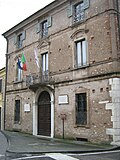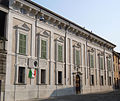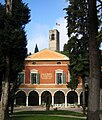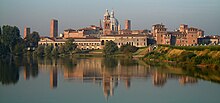| Places of the battle of Solferino and San Martino | |
 | |
| Itinerary type | Automotive |
|---|---|
| State | Italy |
| Region | Lombardy |
| Territory | Alto Mantovano |
| Start | San Martino della Battaglia |
| end | Solferino |
Places of the battle of Solferino and San Martino it is an itinerary that takes place through Lombardy is Veneto.
Introduction
The itinerary runs through the places where, on June 24, 1859, the historic battle of Solferino is Saint martin.
Background

There battle of Solferino and San Martino was fought on June 24, 1859 in Lombardy in the context of the second war of independence by the Austrian army on one side and by the French and Piedmontese on the other. He saw the defeat ofAustria, which with it lost the war and Lombardy.The three armies were commanded by their respective sovereigns: Napoleon III for the France, Vittorio Emanuele II for the Kingdom of Sardinia (officially employed by the French emperor) e Francesco Giuseppe for Austria.
The two allied armies fought together and the Piedmontese formed the left wing of the array. However, post-Risorgimento historiography separated the action of the Piedmontese by isolating it as an event in its own right to which the battle name of San Martino was given. Today the unity of the event is recognized, albeit in Italy remains the battle name of Solferino and San Martino. Elsewhere it is known as the battle of Solferino.
It was the first major battle after the Napoleonic ones, as a total of about 235,000 men took part. The front of the confrontation extended from Lake Garda until Castel Goffredo for about 20 km. The Allied victory was determined mainly by the prudent use of the elite corps of the Imperial Guard, by a better use of cavalry and by the use of the new French rifled guns, more precise and powerful than the Austrian ones.
Here the Red Cross was born
The battle is remembered for being the first concrete step towards national unity and for having inspired a Henry Dunant the idea of International Red Cross, upset by the slaughter of the battle by the total inadequacy of the army's health facility.
How to get
By plane
The nearest airports are:
- 1 Bergamo-Orio al Serio Airport (the Caravaggio), Via Aeroporto 13, Orio al Serio, ☎ 39 035 326323.
- 2 Brescia-Montichiari Airport (Gabriele D'Annunzio), Via Aeroporto, 34, Montichiari (BS), ☎ 39 030 9656599, fax: 39 030 9656514. Charter only
- 3 Verona-Villafranca Airport (Valerio Catullo), Boxes of Sommacampagna (VR), ☎ 39 045 8095666, fax: 39 045 8619074.
By car
The closest motorway exits are:
 Serenissima motorway: Exit Sirmione
Serenissima motorway: Exit Sirmione Brenner motorway: Exit Mantua north, then direction Brescia, Goito
Brenner motorway: Exit Mantua north, then direction Brescia, Goito A21 motorway: Exit Cremona, then direction Mantua, Buttonhole, Castiglione delle Stiviere
A21 motorway: Exit Cremona, then direction Mantua, Buttonhole, Castiglione delle Stiviere
On the train
The nearest stations are:
- 4 Mantua railway station, Don Leoni square. On the directives Verona-Modena.
- 5 Desenzano del Garda railway station, Einaudi square. Served by Frecciabianca for Milano Centrale, Torino Porta Susa, Trieste Centrale and Venezia Santa Lucia; from Frecciarossa to Brescia and Roma Termini and from regional to Milano Centrale and Verona Porta Nuova.
By bike
Numerous cycle paths cross the area (here you can consult the Plan of the Paths and Cycle and Pedestrian Trails of the Province of Mantua):
Stages

Exit at the toll booth of Sirmione of the A4 motorway.
- 6 San Martino della Battaglia - Here the historic battle of the second war of independence was fought on June 24, 1859, in which the forces of the Kingdom of Sardinia, led by Vittorio Emanuele II, allied to the French of Napoleon III, defeated the Austrians, led by the Emperor Franz Joseph.
- 1 [link not working]Monumental tower.
 Full: € 7, reduced: € 5, children: € 3, single ticket: € 10.
Full: € 7, reduced: € 5, children: € 3, single ticket: € 10.  Opening: annual. From 17 March to 15 October: every day 9 - 12.30 / 14.30 - 19, continued 9 - 19 Sundays and holidays. From 16 October to 16 March: from Tuesday to Sunday 9 - 12.30 / 14 - 17.30..
Opening: annual. From 17 March to 15 October: every day 9 - 12.30 / 14.30 - 19, continued 9 - 19 Sundays and holidays. From 16 October to 16 March: from Tuesday to Sunday 9 - 12.30 / 14 - 17.30.. - 2 [link not working]Museum of the Risorgimento of San Martino.
 Full: € 7, reduced: € 5, children: € 3, single ticket: € 10.
Full: € 7, reduced: € 5, children: € 3, single ticket: € 10.  From 17 March to 15 October: Mon-Sat 9: 00-12: 30 and 14: 30-19: 00, Sun and holidays 9: 00-19: 00. From 16 October to 16 March: Tue-Sun 9: 00-12: 30 and 14: 00-17: 30.
From 17 March to 15 October: Mon-Sat 9: 00-12: 30 and 14: 30-19: 00, Sun and holidays 9: 00-19: 00. From 16 October to 16 March: Tue-Sun 9: 00-12: 30 and 14: 00-17: 30. - 3 [link not working]Ossuary of San Martino.
 Free entry.
Free entry.
- 1 [link not working]Monumental tower.

- 7 Rivoltella del Garda —
- 4 Villa Brunati. After the battle of San Martino, it hosted Vittorio Emanuele II with his General Staff from 25 to 30 June 1859.
- 8 Centennial —
- 9 Venzago Castle —

- 10 Castiglione delle Stiviere - Many buildings in the historic center hosted and were treated for the wounded in the battle of Solferino.
- 5 International Red Cross Museum.
- 6 Museum of Palazzo Bondoni Pastorio (Museum of Palazzo Bondoni Pastorio), Via Marconi 34. The palace hosted Henry Dunant in the days following the battle of Solferino, who conceived the first idea of the Red Cross here.
- 7 Monument to heroic women, Via Marconi - Piazza Duomo. It recalls the Castiglionese women who did their utmost to care for the wounded after the battle of Solferino and San Martino.
- 11 Montichiari - It was the headquarters of the headquarters of the French army.
- 12 Grole di Castiglione - The 1st French Army Corps passed through here, coming from Esenta and headed for Solferino.
- 13 Monte Medolano - This small hill was the scene of war already in 1706 and 1796. In 1859 there was the general staff of General Mac-Mahon, who on the hill agreed with Napoleon III and directed the attack from the south to the Austrian positions of Solferino.
- 14 Castel Goffredo - The 3rd French Army Corps was deployed in the area, under the command of General François Certain de Canrobert, who on the morning of June 24, 1859, prior to the battle of Medole, freed the fortress city from the Austrian cavalry.
- 8 Plaque to General Canrobert, Mazzini square (Loggia of the Town Hall.). The plaque commemorates the undertaking of General Canrobert, who freed the city from the Austrians.
- 15 Medole - Here took place the clash that started the battle of Solferino and San Martino, with which the war activities of the second war of independence ended. The battle of Medole lasted incessantly for 15 hours, leaving numerous victims on the field.
- 9 Ceni Palace, Via Roma (Municipal property, but not yet open to the public.). The palace was used as an infirmary to care for the wounded after the bloody battle of Medole and the French colonel Louis-Charles de Maleville died in it.

- 16 Cà Morino —
- 10 French war memorial. The monument recalls that on June 24, 1859, the French clashed with the Austrians here, put to flight after a bitter fight. During the battle, the French general Charles Auger was also wounded in the left shoulder, who was taken in agony to nearby Castiglione, where he was treated and where he died on 30 June.

- 17 Rebecco —
- 11 Cenotaph of Karl Windisch-Graetz, Case Nuove location. It is dedicated to the Austrian prince Karl Windisch-Graetz who fell together with a thousand soldiers and dozens of senior officers, including the French colonel Louis-Charles de Maleville.
- 12 Cenotaph of Admell Tonnelier, Case Nuove location. It is dedicated to the French captain Admell Tonnelier, an officer of Napoleon III of the 6th Battalion of hunters on foot, who fell together with a thousand soldiers and dozens of senior officers, including the French colonel Louis-Charles de Maleville and the Austrian colonel Karl Windisch -Graetz.
- 18 Guide it - The Austrian 1st Army was deployed here.
- 19 Castelgrimaldo —
- 20 Goito - The retreating Austrian army passed through here.
- 21 Volta Mantovana - The VII Corps of the Austrian army was deployed here.
- 22 Cavriana - The I Corps of the Austrian army was deployed here.
- 13 Villa Mirra. After the victory in the battle, Napoleon III and King Vittorio Emanuele II found themselves victorious here.

- 23 Valeggio sul Mincio - It was the seat of the Austrian army headquarters.
- 24 Pozzolengo - The Austrian 2nd Army was deployed here.

- 25 Madonna of the Discovery - In the area the Sardinian army forced the Austrian brigades to retreat.
- 14 Sanctuary of the Madonna della Scoperta. The church was used as a field hospital on the occasion of the battle, which was resolved victoriously here also thanks to the Sardinian intervention.

- 26 Solferino - It is the best known town for the battle of June 24, 1859, fought between the Austrian and Franco-Sardinian armies as the final and conclusive act of the second war of independence.
- 15 Fortress of Solferino (The Spy of Italy), Via Rocca.
 Whole and groups with guide (reservations required): € 2.5, reduced and groups: € 2, children 6-10 years: € 1, single ticket: € 10.
Whole and groups with guide (reservations required): € 2.5, reduced and groups: € 2, children 6-10 years: € 1, single ticket: € 10.  Open from 17 March to 15 October: 9.00 - 12.30 14.30 - 19.00 Closed on Mondays - From 16 October to 16 March: opening only for groups by reservation (tel. 0376 854019). With the capture of the fortress, the battle of Solferino ended.
Open from 17 March to 15 October: 9.00 - 12.30 14.30 - 19.00 Closed on Mondays - From 16 October to 16 March: opening only for groups by reservation (tel. 0376 854019). With the capture of the fortress, the battle of Solferino ended. - 16 Red Cross Memorial, Via della Rocca (In the park below the Rocca).
 Free admission. It was erected in 1959, on the centenary of the battle, to commemorate the figure and work of Henry Dunant, founder of the Red Cross.
Free admission. It was erected in 1959, on the centenary of the battle, to commemorate the figure and work of Henry Dunant, founder of the Red Cross. - 17 Museum of the Risorgimento of Solferino, Via Ossario, ☎ 39 030 9910370, fax: 39 030 9910370.
 Whole and groups with guide (reservations required): € 2.5, reduced and groups: € 2, children 6-10 years: € 1, single ticket: € 10.
Whole and groups with guide (reservations required): € 2.5, reduced and groups: € 2, children 6-10 years: € 1, single ticket: € 10.  From Tuesday to Sunday (closed Monday) - From March 17 to October 15 9-12.30 and 14.30-19. In the winter months by reservation.
From Tuesday to Sunday (closed Monday) - From March 17 to October 15 9-12.30 and 14.30-19. In the winter months by reservation. - 18 Ossuary, Via Ossario.
- 15 Fortress of Solferino (The Spy of Italy), Via Rocca.
Return
Take the A4 motorway at the tollbooth of Sirmione.

Safety
Image gallery

Medole, Palazzo Ceni
Medole, Tomb of honor of Ca 'Fattori

Rebecco, Cenotaph of Admell Tonnelier

Cavriana, Villa Mirra

San Martino della Battaglia, Ossuary

Solferino, Ossuary

Solferino, Rocca

Solferino, Red Cross Memorial
Castiglione delle Stiviere, monument to the women who rescued the wounded

Castel Goffredo, plaque to General Canrobert

Monte Medolano, plaque to Napoleon III

Madonna of the Discovery, plaque in memory of the battle
Around
Excursions
- Lake Garda - It is one of the great Lombard lakes; the eastern shore is Venetian, the tip to the north it is thirty. A destination for climatic tourism since the nineteenth century, every coastal town lives and develops with tourism. Main destinations are Sirmione, Desenzano del Garda, Salò, Riva del Garda, Garda, Peschiera del Garda.
- Castellaro Lagusello —
- Borghetto (Valeggio sul Mincio) —
- Mantua - Capital of the Gonzagas, it still exudes its subtle charm as a great city of art for which it appoints it a UNESCO World Heritage Site it was not so much a recognition as a necessary acknowledgment. Its ancient atmospheres are incomparable, the profiles of the palaces and domes that stand out in the Po Valley mist enveloped by the mirror of its lakes, its endless Gonzaga palace that incorporates numerous buildings in the city center.
Itineraries

- Morainic hills of Lake Garda - On the first corrugations of the Po plain that becomes a hill, where the great lake basin of the Lake Garda, the route touches towns and cities that were the domain of Gonzaga, Venice, Scaligero, and then became the scene of the bloody battles of the Risorgimento that were the prelude to the unification of Italy. To the tourist, historical and naturalistic importance the area combines an oenological interest as an area of production of wines from the hills, tokai, merlot and claret.
- In the lands of the Gonzaga - An itinerary through the centers, large and small, which were the capitals of the Gonzaga cadet branches: principalities, marquisates, duchies which, within the Mantuan state structure, enjoyed real independence, often minted coins and held refined courts that rivaled that of Mantua, embellished their urban centers by equipping them with elegant architecture - churches, squares, palaces, walls, towers - and characteristic urban views such as the typical Gonzaga arcades.
- Rural churches and oratories of Castel Goffredo - The itinerary, entirely in the green countryside rich in waterways, runs through the numerous places of worship, which boast ancient traditions and are the sign of a widespread religiosity, since the sixteenth century.
- Way of faith and solidarity - The itinerary runs through the places where two saints lived, St. Luigi Gonzaga is Saint Angela Merici, and a blessed one, Paola Montaldi; where important pages of the Risorgimento and saw the birth of the Red Cross.













